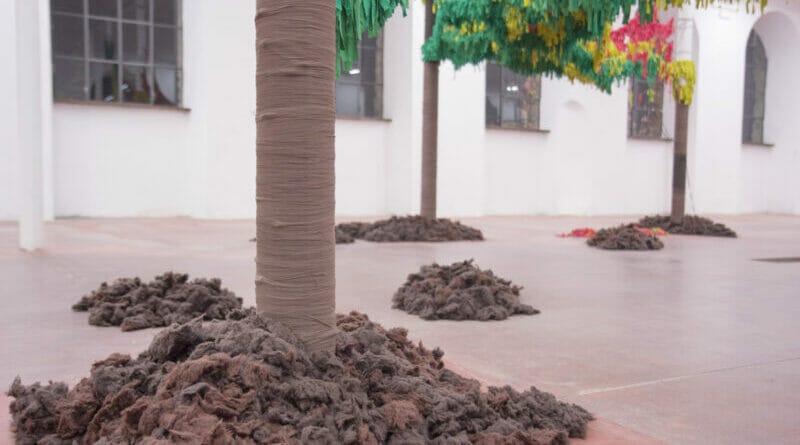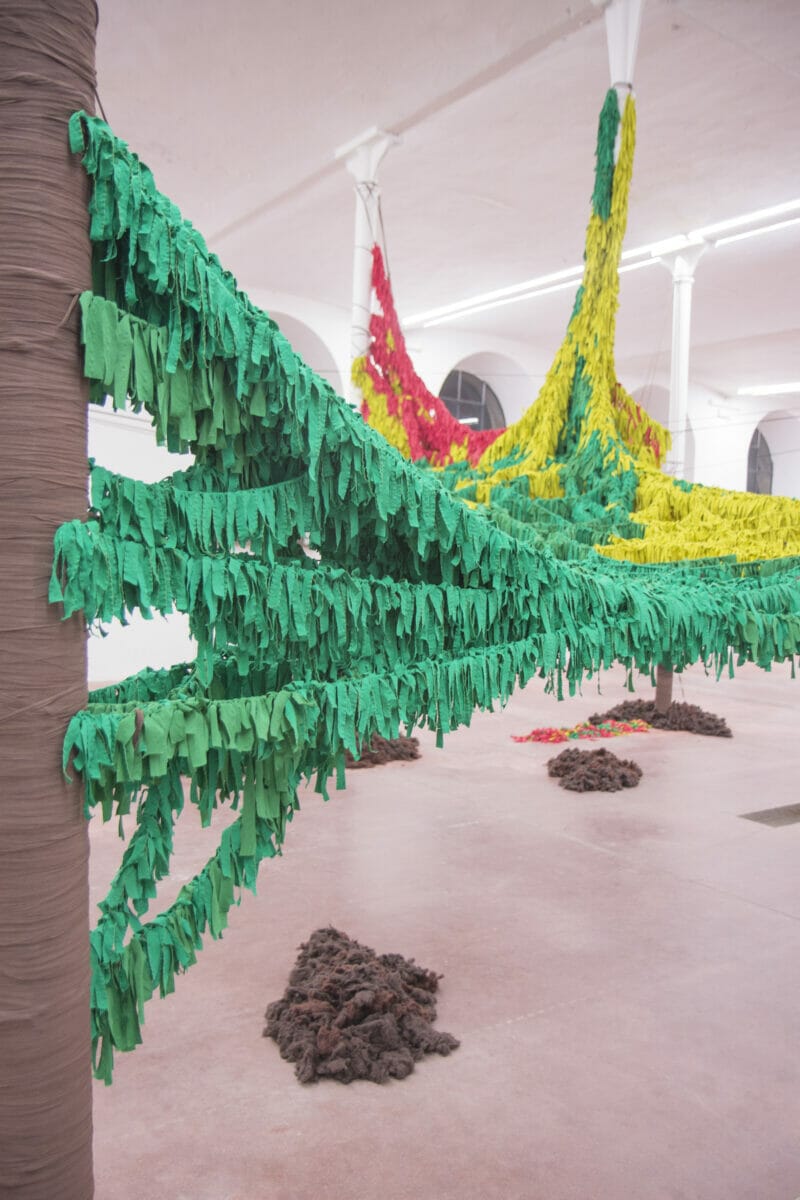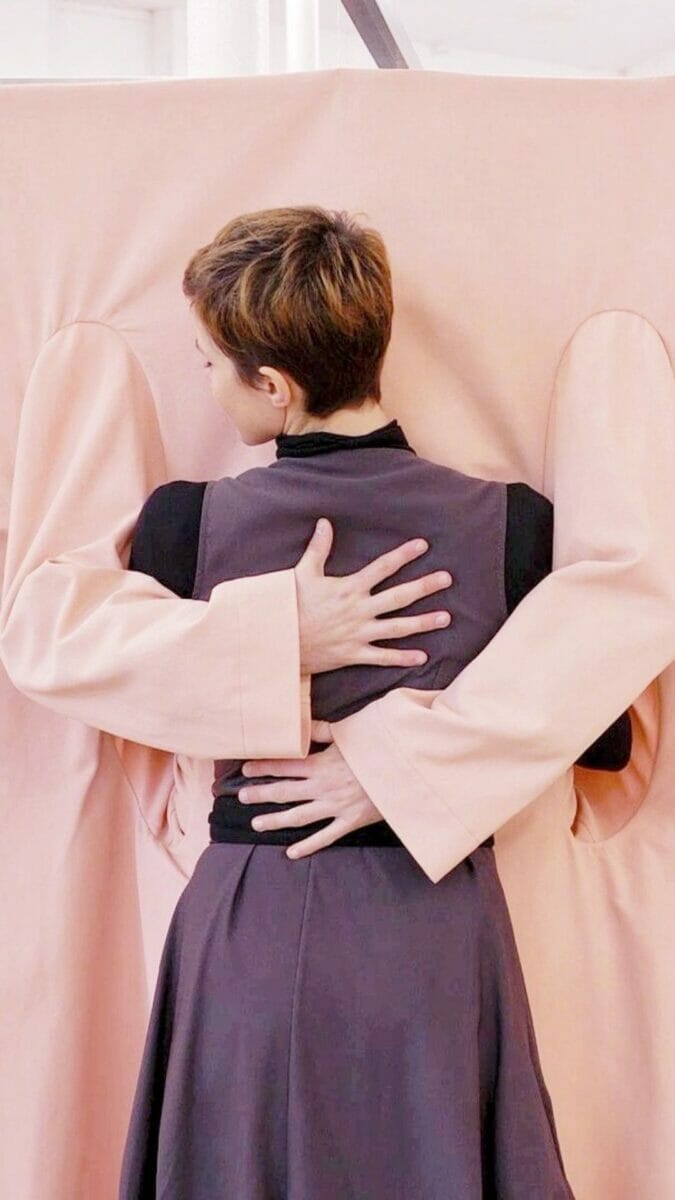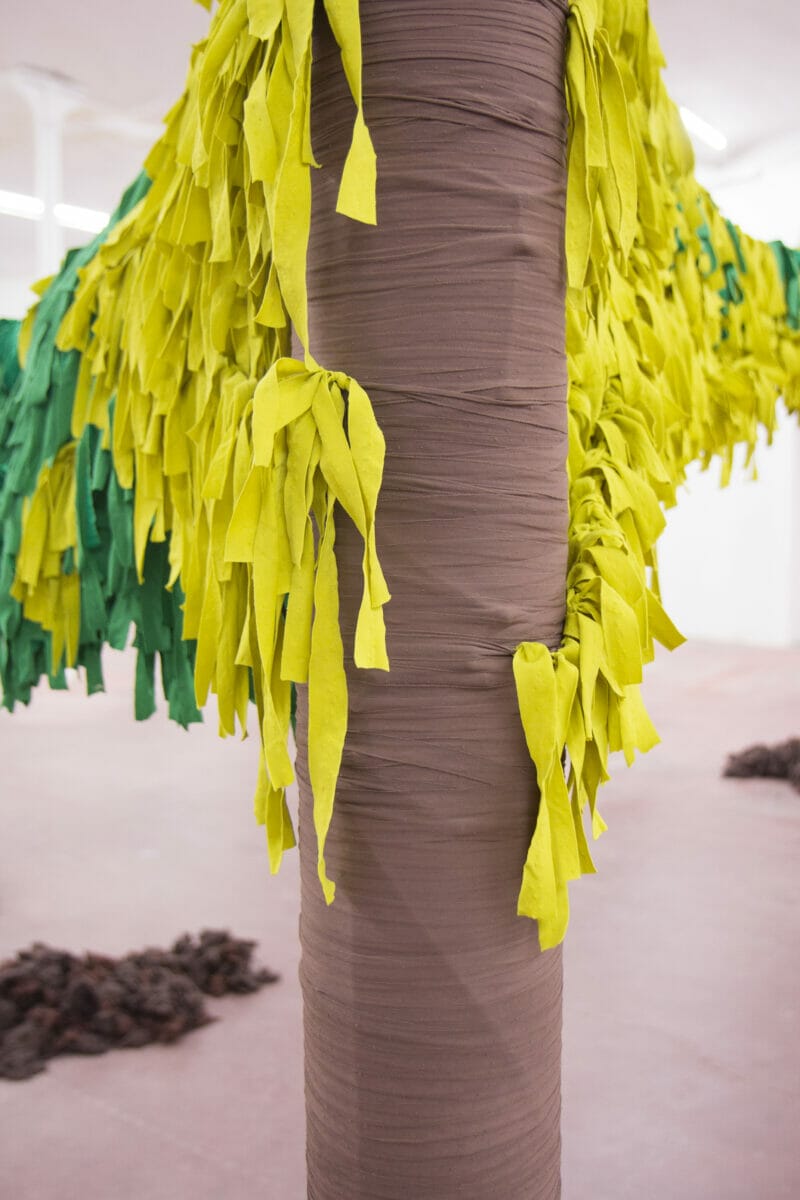GIULIA PELLEGRINI
The study carried out by Giulia Pellegrini focuses on the relationship that is established between the individual and the surrounding environment. Her research mixes the performative dimension with the installation, it follows the creation of an immersive space in which the individual is confronted with matter and its characteristics.
In your artistic research a predilection for textile materials is evident. From where does this interest arise?
The interest in textile materials began during the academic period. I was looking for a living material, capable of adapting to the surfaces with which it came into contact and I found the perfect material in the fabric. From that moment I embarked on a journey into fabrics and yarns to discover their characteristics and I have attended courses of all kinds to understand the possibility that this material could offer me.The fabric that arises from the interdependence of warp and weft tells a story, records memories, builds social cohesion, incorporating equity and environmental awareness.
Including all this, I could only fall in love with it and decide to prefer only this material in my projects.
In 2021 you created Ambiente, a large site-specific installation for Cittadellarte Pistoletto Foundation born during the Circulart 2.0 artist residency. Can you tell us how it was born and what was the evolution of the project?
Circulart 2.0 Art Interwoven with the Supply Chain is a project curated and produced
by Cittadellarte which allows artists to deal with the different sectors that make up the textile supply chain through collaboration with companies that have decided to embrace an ethic of respect for our planet. Thanks to this project I have recognized that I am a guest on this planet and how much my freedom of decision and of action requires not only awareness but also information about what I consume and what my choices determine.
From this observation was born Ambiente, a forest entirely built with polyester selvedges (waste material produced by a textile company visited during the residency) and deliberately composed of elementary knots juxtaposed to each other to demonstrate the impact that each of our little choices has on the Planet. Ambiente invites the public to decide whether to complete this place knowing that we will add more non-recyclable material or to consciously choose to leave it incomplete.
With Ambiente I have recreated nothing but a lifeless ecosystem, not very different from the one we selfishly built with our clothes in the Atacama desert.
Again in the same context, another project was born that you entitled Abito (Dress), in this case the attention seems to focus on the relationship between the self and the other. What is the message you want to spread through this work?
The message of care and respect towards ourselves, others and the Planet through the analysis of one of the three essential needs of the human species: dressing. Today we dress not so much to satisfy concrete needs, such as to protect ourselves from external agents, but to take possession of symbols to exhibit.
In the space of a few decades there we are distanced from the thought that the dress is an extension of our skin (to resume the words of the sociologist Marshall McLuhan) and that as such it is important that it overlaps harmoniously with it. The fabric used in the construction of a suit has more than just value because of the time and skill required to build it but because it tells a story a lot complex which involves numerous transformations of matter and which deserves for this reason respect and care.
For Abito I wanted to use five different fabrics from five textile companies partners of the Circulart2.0 project: three of animal origin (alpaca, wool, silk), two of origin vegetable (linen, cotton, cotton linen lyocell blend) dyed through natural dyeing each featuring a long tag and different double wearables (double pocket, double glove, double stole, double scarf, double sleeve).
The chosen fabrics have been intentionally dyed with the Rubia Tinctorum plant to show the hues that a natural dye is able to give to a fabric compared to synthetic ones; the label shows the history of the fabric by contrasting with the labels we are used to find on our garments; and the dual wearables are tasked with inviting the audience to share this extension of ours with another person.
The title chosen for the installation, Abito, invites us to reflect not only on the dress as a garment but on the word “Inhabit”. Our body inhabits the dress and if we take care of it and respect it in turn it
may be inhabited by others. By learning to guard what we have, we learn to protect and to have respect also for others and consequently for our Planet.
In recent years, you have participated in various residencies for artists held in different different cities and environments. What do you think of this type of context? Is it really training for an artist?
I am convinced that artistic residencies are very educational, at least the ones I have chosen and in which I have been selected. They have allowed me to grow both from an artistic-professional and human point of view. I was able to collaborate and discuss with scientists, architects, designers, Alpine troops, psychiatric patients, prisoners, the elderly, children and companies and come into contact with unique places and landscapes. They taught me to appreciate each other, not to judge and that dialogue is something extremely precious.
What is the project you are most linked to and why?
I feel connected to every project carried out in the last two years because it is the result of careful, conscious and mature research but Abitante, a work born during the Falia* residency in Valle Camonica, has a special place in my heart.
To reconnect with the previous question, thanks to this residency I was able to create a dream of mine: to be able to collaborate with a dancer (Alice Tagliaferri), a local inhabitant, whom I would like to thank.
Abitante is special because it speaks in every millimeter of the territory that hosted me for about a month. I used old sheets donated to me by an inhabitant, then I painted them using two plants found on the spot (Ipericum Perforatum and walnut husk), I embellished them with mother-of-pearl buttons made from the Tectus Dentatus mollusc (because years ago it was active in the Lozio Valley a button factory that produced them) and finally I was able to collaborate with this wonderful dancer.
Abitante shows the interactions that have taken place over the centuries between the human species and the environment through a female body that acts and moves between four panels doubled in green and brown fabric. Thanks to the buttons on the fabrics, it invites us to transform the ways in which we plan our exchanges with the environment and to redesign our paths as inhabitants of this planet.
How do you choose the materials with which you make your works?
I try to choose materials that have a very low environmental impact. Mostly these are fabrics and yarns of cellulosic or protein origin that come from faulty lots or from Italian or foreign companies that embrace my same values. In most cases I use undyed yarns and fabrics to be able to personally dye them through color baths obtained from different types of plants. Natural dyeing is a tool that allows me to reconnect with what is the environment in which I live and to have Nature as my grip collaborator in every phase of development of my project.
What are you working on now and what are your next projects?
I have just concluded a project, entitled Albedo, born with the aim of denouncing the melting of glaciers caused by anthropogenic climate change and the need to sensitize the public to adhere to a conservation ethic. It looks like a large cape (whose fabric was obtained from the albedo of oranges) equipped with a wearable hood, characterized by a white external part and a gray and blue shaded internal part. While the outside shows the living glacier, the inside reveals its decay. The public wearing Albedo brings the glacier back to life, taking it off brings it back to its current state of melting and decay.
Albedo is the first work in a series that will keep me busy all year. Future projects will be tied to everything we are in danger of losing. I will talk about the Amazon, Coral Reefs, the Ocean, Wetlands and Biodiversity.



